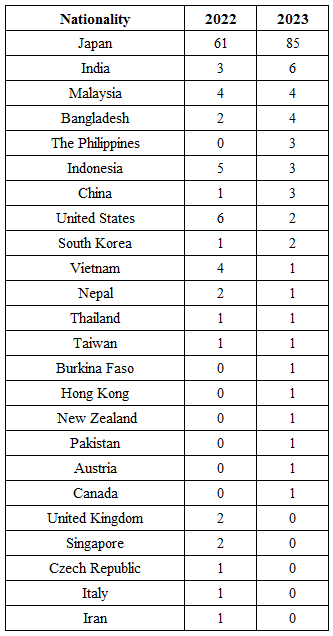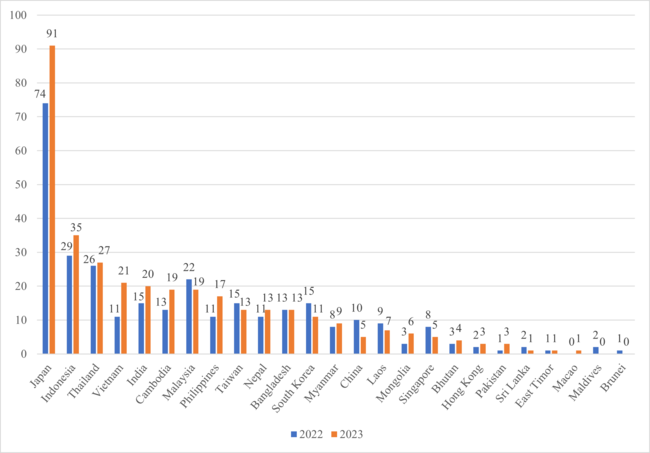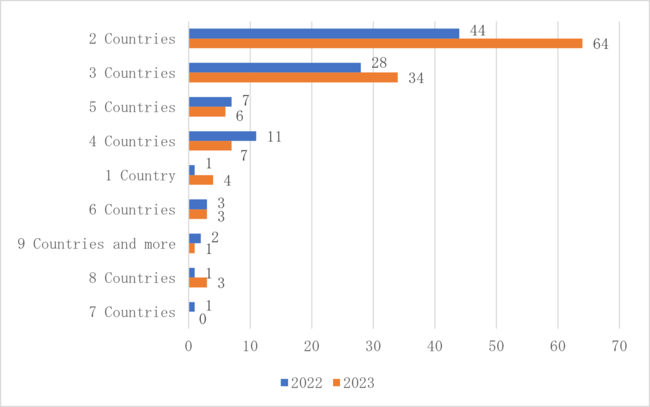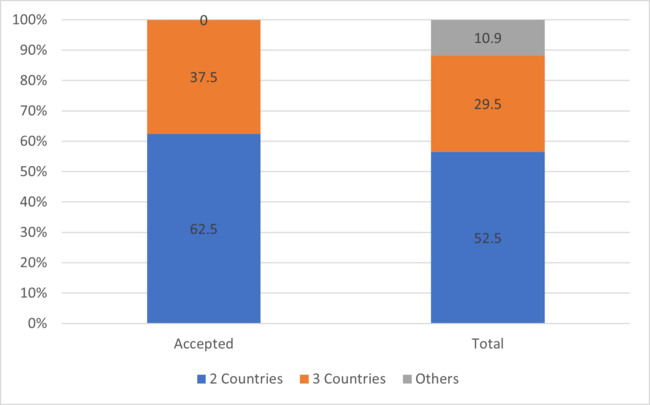Selection Committee Chair Prof. Shigeto Sonoda
Outline of Fiscal 2023 International Grant Program “Cultivating Empathy Through Learning from Our Neighbors: Practitioners’ Exchange on Common Issues in Asia”
The COVID pandemic has almost gone away and there are hardly any obstacles to traveling abroad. Since last fiscal year, the International Grant Program has come to cover South Asian nations including Bangladesh, Bhutan, India, Maldives, Nepal, Pakistan and Sri Lanka, but the application guidelines for this fiscal year have not changed.
The essence of the International Grant Program is, as it has been from before, to support proposed projects that are aimed at solving common issues in Asia through learning from each other and include the following four elements.
(1) Transnationality: The project must cover at least two countries in East Asia, Southeast Asia, and South Asia, and the project members must also be from at least two countries. In addition, any achievement made through the project or an effect produced by it must cover multiple countries.
(2) Cross Sectoral Approach: A sufficient number of experts from multiple sectors (such as researchers, NPO staff, businesspersons, and government officials), who are to solve the problem, must be participating in the project under an organic relationship.
(3) Mutual Learning: Project participants must have built a relationship of mutual learning to carry out the project.
(4) Foresight: The project must have a clear vision of its outcomes and must consider the impact it will have after the end of the grant and the possibility of its future development. It must also cover problems that could occur in the future and reflect a new perspective beyond conventional frameworks.
Overview of the Situation and Details of Application
The open call for proposals started on April 3 in fiscal 2023, and applications were accepted for about two months until June 3. The Foundation held two online briefing sessions, one on April 12 and the other on April 18, and nearly 100 people participated in the sessions. Fifty-seven prior consultations were provided face-to-face, online or in other forms. We had 267 pre-application registrations and 122 of these (45.7%) advanced to the final application process. We saw improvements since 40.5% of pre-registrants advanced to the final application process last year. Also, we had 24 more applications than the 98 we received in fiscal 2022.
Nine of the 122 applications were for the One-Year Grant. This was only a little higher than 7% of the whole. This means there was a significant drop in applications for the One-Year Grant as they were 17.3% of the awarded grants last fiscal year. This is another example showing that the COVID-19 pandemic is almost over.
The distribution of nationalities of applicants is shown in Table 1. In fiscal 2022, a little more than 62% of all applicants were Japanese nationals, while in FY2023, the percentage was a little lower than 70%, returning to the normal level. This is the second year since the program began to cover South Asia, and partly because of this, citizens of countries such as India and Bangladesh were more of the applicants while the number of applicants from the United States and Vietnam decreased. The total number of applications increased from last year, which can be attributable to our receiving more applications from people with Japanese citizenship.
Table 1: Distribution of the nationalities of project representatives for fiscal 2022-2023

Fig. 1 shows the distribution of countries/regions stated in the proposed projects and Fig. 2 shows the number of the countries/regions covered by the project.
More projects covered Southeast Asian countries like Indonesia, Vietnam, Cambodia and the Philippines than last year. On the other hand, the number of projects covering Taiwan, South Korea and China decreased slightly. Overall, coverage of East Asia is less than before. This year, we had more proposals than in the past for projects that cover fewer countries or regions. It seems many of the proposals intended to start their project from a small scale due to the suspension of the project during the pandemic.
Fig. 1: Targeted countries/regions that were stated in application forms for fiscal 2022- 2023

Fig. 2: Number of targeted countries/regions that were stated in application forms in 2022-2023

Selection process and results
The selection committee is made up of four members including the committee chair. The members remain unchanged from last year. For this reason, we were always able to keep the comparison with the previous year in mind during the selection process.
First, program officers (POs) sorted out submitted documents and closely reviewed the 122 applications. They eliminated incomplete application forms and applications that were judged to not include the four elements described above, before the selection committee was asked to evaluate the remaining applications. (For example, as Fig. 2 shows, four applications in fiscal 2023 covered only one country and were treated as outside the scope of the evaluation.)
The four members of the selection committee read the applications carefully and selected the applications that they could recommend, with some weight on the projects that the committee members found most impressive. When a question arose about project details, schedule, budget plans or any other related matters, or room for improvement was found in the dissemination of achievements and results, the selection committee members informed the POs, who directed the questions/concerns to the applicants and communicated their replies to members of the selection committee. Then, the results of the reviews by the four selection committee members were collated before the selection committee meeting was held.
The committee eliminated applications that had not been recommended by anyone. All members of the selection committee commented on each of the applications that at least one of the members had recommended, and examined the replies from the applicants before discussing the applications individually and deciding whether to select them. They made the final decision on the winning projects by checking for the overlap in the countries or regions covered and project themes and adjusting the amounts of grants to 70,000,000 yen in total.
The eight projects selected for this fiscal year have the following characteristics.
First, all eight of the winning projects are for the Two-Year Grant, and none were selected from applications for the One-Year Grant. In my commentary on the selection results for fiscal 2021, I pointed out that the applications for the Two-Year Grants conveyed more enthusiasm and many of them delivered a strong message like, “A project like this is all the more necessary because we are in the middle of the COVID-19 pandemic.” A similar trend was seen this fiscal year as well.
Second, the total number of countries or regions covered by the winning projects is smaller than before. As Fig. 3 shows, 52.5% of all proposed projects covered two countries, while 62.5% of the selected projects covered two countries, which is up 10 percentage points. None of the selected applications covered four or more countries. In that regard, this fiscal year is slightly different from past years.
Third, past recipients of grants from the Toyota Foundation have always been a relatively large proportion of the successful applicants, but that is not true this fiscal year. Thirty-four of the 122 applicants had been previously selected by the Foundation, which is 28% of the all applicants. However, two of the eight selected applicants (25%) had been selected before, showing a minor difference from the overall trend.
Fig. 3: Numbers of targeted countries/regions that were stated in the applications: Ratios to the number of selected projects and the total number of applications (%)

The problems common throughout Asia addressed by the selected projects included environmental issues and the aging population. This fiscal year, we received more proposals related to disaster prevention and control and fewer proposals related to immigration. The latter may be because more candidates applied for another Foundation program on a Special Subject, “Migrants and Japanese Society” or because the immigrant issue has entered a different phase now that the pandemic is settling.
While nine applications were selected last fiscal year, eight were selected this time. Thus, there was an increase in the amount granted per selected application.
Introducing Adopted Projects
Two of this fiscal year's winning projects which were highly evaluated by the selection committee members are introduced below.
| Kazuo Koyama, "Coffee in Asia Made Sustainable by Wild Birds: Sustainable Coffee Promotion Business Promoted by Two Southeast Asian Countries with Environmental Evaluation Approaches Using Wild Birds as an Index" |
| Countries: The Philippines and Indonesia |
| Term: 2 years |
| Amount: 8,600,000 yen |
With a focus on wild birds that have no borders, the project brands the coffee produced in the covered regions by simultaneously conducting environmental assessment using the wild birds as an index and wild bird research, in an effort to conserve the forest. The proposer who specializes in wild bird observation seeks to achieve its targets by cooperating with NGOs and public officials in the Philippines and Indonesia and Japanese coffee importers. The proposal was highly regarded for its novel idea and solid preparation for the implementation of the project. Going forward, we expect the impact of the project will be increased by concentrating on branding the coffee in the regions.
| Keiko Azuma, "Supporting Caregivers in Japan and South Korea: Supporting Caregivers Confronting Double Responsibility of Care and Young Caregivers, and Mutual Learning for a Caring Democracy, Local Communities with Substantial Care" |
| Countries: Japan and South Korea |
| Term: 2 years |
| Amount: 9,300,000 yen |
Leveraging an established track record and network created by the project selected in the fiscal 2015 International Grant Program, “Proposing Supports for People Confronting Double Responsibility of Care,” this new project focuses on mutual learning in Japan and Korea which was not expanded full scale in the previous project, especially learning from cases in Korea where there has been an accumulation of gender-related legislation. Because this is a serious issue for Japan, the selection committee members were strongly interested in the project which introduced the term “double care” to the general public in Japan. The applicants have actively continued awareness-raising activities and our expectations for the applicants’ collaboration with Korea is high.
Conclusion
In recent years, the International Grant Program has often implemented minor changes such as the revision of application (applicant) requirements and the increase of the number of countries covered., but no changes have been implemented since the previous fiscal year. Furthermore, all of the members of last year's selection committee stayed, which made it easier for us to focus on the changes to the contents of the application.
We received fewer proposals for academia-led projects (led by university professors) but more proposals for practitioner-led projects (led by NGO-related people and others) than before. Possibly because of this, the committee members who are familiar with the latter had severe comments on some projects, pointing out the lack of novelty in this fiscal year’s proposals and an overall lack of appeal. Meanwhile, other committee members who are well-versed in the former had different ideas. They viewed many proposals from people involved in NGOs as solid and highly feasible in a more positive sense.
It’s good news that we received more applications than in previous fiscal years, but this is meaningless if they are not of good quality. Increasing the appeal of proposals might require a new program that teaches how to write the application form properly. The Foundation may have entered a stage where this kind of new program will be developed to reach potential applicants.
